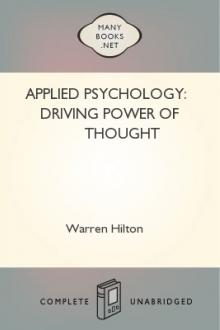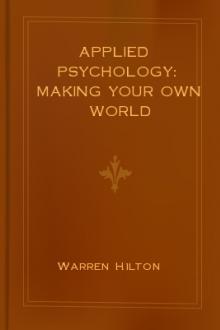Power of Mental Imagery by Warren Hilton (best free e reader TXT) 📕

- Author: Warren Hilton
- Performer: -
Book online «Power of Mental Imagery by Warren Hilton (best free e reader TXT) 📕». Author Warren Hilton
“I can look down the mentally seen page and see the words that commence all the lines, and from any one of these words I can continue the line. I find this much easier to do if the words begin as in a straight line than if there are breaks. Example:
Etant fait
Tous .............
A des ............
Que fit ..........
Ceres ............
Avec ...........
Un fleur .........
Comme ..........
(La Fontaine S. IV.)”
The poor visualizer says:
“My ability to form mental images seems, from what I have studied of other people’s images, to be defective, and somewhat peculiar. The process by which I seem to remember any particular event is not by a series of distinct images, but a sort of panorama, the faintest impressions of which are perceptible through a thick fog—I cannot shut my eyes and get a distinct image of anyone, although I used to be able to a few years ago, and the faculty seems to have gradually slipped away. * * * In my most vivid dreams, where the events appear like the most real facts, I am often troubled with a dimness of sight which causes the images to appear indistinct. * * * To come to the question of the breakfast-table, there is nothing definite about it. Everything is vague. I cannot say what I see. I could not possibly count the chairs, but I happen to know that there are ten. I see nothing in detail. * * * The chief thing is a general impression that I cannot tell exactly what I do see. The coloring is about the same, as far as I can recall it, only very much washed out. Perhaps the only color I can see at all distinctly is that of the tablecloth, and I could probably see the color of the wall paper if I could remember what color it was.”
This difference between individuals is just as marked in the matter of ability to form auditory images as in respect to visual images.
Thus, Professor Walter Dill Scott, of Northwestern University, cites the following:
“One student who has strong auditory imagery writes as follows: ‘When I think of the breakfast-table I do not seem to have a clear visual image of it. I can see the length of it, the three chairs—though I can’t tell the color or shape of these—the white cloth and something on it, but I can’t see the pattern of the dishes or any of the food. I can very plainly hear the rattle of the dishes and of the silver and above this hear the conversation, also the other noises, such as a train which passes every morning while we are at breakfast. Again, in a football game I distinctly hear the noise, but do not see clearly anything or anybody. I hear the stillness when everyone is intent and then the loud cheering. Here I notice the differences of pitch and tone.’
“I had read that some people were unable to imagine sounds which they had heard, but it had not impressed me, for I had supposed that such persons were great exceptions. I was truly surprised when I found so many of my students writing papers similar to those from which extracts are here given: ‘My mental imagery is visual, as I seem to see things and not hear, feel or smell them. The element of sound seems practically never to enter in. When I think of a breakfast-table or a football game I have a distinct image. I see colors, but hear no sound.’
[Textual representation of advertisement]
“Another in describing his image of a railroad-train, writes: ‘I am not able to state whether I hear the train or not. I am inclined to think that it is a noiseless one. It is hard for me to conceive of the sound of a bell, for instance. I can see the bell move to and fro, and for an instant seem to hear the ding, dong; but it is gone before I can identify it. When I try to conceive of shouts I am like one groping in the dark. I cannot possibly retain the conception of a sound for any length of time.’
“Another, who seems to have no vivid images of any kind, writes: ‘When I recall the breakfast-table I see it and the persons around it. The number of them is distinct, for there is only one of them on each side of the table. But they seem like mere objects in space. Only when I think of each separately do I clearly see them. As for the table, all I see is a general whiteness, interspersed with objects. I hear nothing at all, and indeed the whole thing is so indistinct it bewilders me when I think of it. My mental imagery is very vague and hazy, unless I have previously taken special notice of what I now have an image of. For instance, when I have an image of a certain person I cannot tell his particular characteristics unless my attention was formerly directed to them.’
“Another writes: ‘There is no sound in connection with any image. In remembering, I call up an incident and gradually fill out the details. I can very seldom recall how anything sounds. One sound from the play “Robespierre,” by Henry Irving, which I heard about two years ago and which I could recall some time afterward, I have been unable to recall this fall, though I have tried to do so. I can see the scene quite perfectly, the position of the actors and stage setting, even the action of a player who brought out the sound.’
“Quite a large proportion of persons find it impossible to imagine motion at all. As they think of a football game, all the players are standing stock-still; they are as they are represented in a photograph. They are in the act of running, but no motion is represented. Likewise, the banners and streamers are all motionless. They find it impossible to think of such a thing as motion. Others find that the motions are the most vivid part of their images. What they remember of a scene is principally movement.
“One writes: ‘When the word “breakfast-table” was given out I saw our breakfast-table at home, especially the table and the white tablecloth. The cloth seemed to be the most distinct object. I can see each one in his place at the table. I can see no color except that of the tablecloth. The dishes are there, but are very indistinct. I cannot hear the rattle of the dishes or the voices very distinctly; the voices seem much louder than the dishes, but neither are very clear. I can feel the motions which I make during the breakfast hour. I feel myself come in, sit down and begin to eat. I can see the motions of those about me quite plainly. I believe the feeling of motion was the most distinct feeling I had. When the word “railroad-train” was given I saw the train very plainly just stopping in front of the depot. I saw the people getting on the train; these people were very indistinct. It is their motions rather than the people themselves which I see. I can feel myself getting on the train, finding a seat, and sitting down. I cannot hear the noise of the train, but can hear rather indistinctly the conductor calling the stations. I believe my mental imagery is more motile (of movement) than anything else. Although I can see some things quite plainly, I seem to feel the movements most distinctly.’
“A very few in describing their images of the breakfast-table made special mention of the taste of the food and of its odor. I have discovered no one whose prevailing imagery is for either taste or smell. With very many the image of touch is very vivid. They can imagine just how velvet feels, how a fly feels on one’s nose, the discomfort of a tight shoe, and the pleasure of stroking a smooth marble surface.”
HOW TO INFLUENCEOTHERS THROUGH MENTAL
IMAGERY
The practical importance of the fact of mental imagery and of the individual differences in power of mental imagery is very great. They should be particularly taken into account in any business or profession in which one seeks to implant knowledge or conviction in the mind of another.
The underlying principle in such cases is this: To the mind you are seeking to convince or educate, present your facts in as many different ways and as realistically as possible, so that there may be a variety of images, each serving as a clue to prompt the memory.
We cannot do more at this point than indicate a few minor phases of the practical application of the principles of mental imagery.
In the old days geography was taught simply with a book and maps. Today children also use their hands in molding relief maps in sand or clay, and mountains and rivers have acquired a meaning they never had before.
In the days of the oral “spelling match” boys and girls were better spellers than products of a later school system, because they used not only the eye to see the printed word, the arm and hand to feel in writing it, but also the ear to hear it and the vocal muscles to utter it. And because of this fact oral spelling is being brought back to the schoolroom.
If you have pianos to advertise, do not limit your advertisement to a beautiful picture of the mahogany case and general words telling the reader that it is “the best.” Pianos are musical instruments, and the descriptive words should first of all call up delightful auditory images in your reader’s mind.
If you have for sale an article of food, do not simply tell your customer how good it is. Let him see it, feel it, and particularly taste it, if you want him to call for it the next time he enters your store.
Turn, for example, to the advertisement of a certain brand of chocolate, facing page 6. The daintily spread table, the pretty girl, the steaming cup, the evident satisfaction of the man, who looks accustomed to good living,—these elements combine in a skilful appeal to the senses. Turn now to another advertisement of this same brand of chocolate, shown facing page 22. The purpose here is to inform you as to the large quantity of cocoa beans roasted in the company’s furnaces. Whether this fact is of any consequence or not, the impression you get from the picture is of a wheelbarrow full of something that looks like coal being trundled by a dirty workman, while the shovel by the furnace door and the cocoa beans scattered about the floor remind one of a begrimed iron foundry.
The only words that will ever sell anything are graphic words, picturesque words, words that call up distinct and definite mental pictures of an attractive kind.
The more sensory images we have of any object the better we know it.
If you want to make





Comments (0)